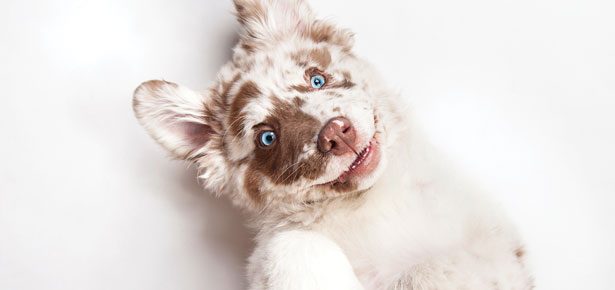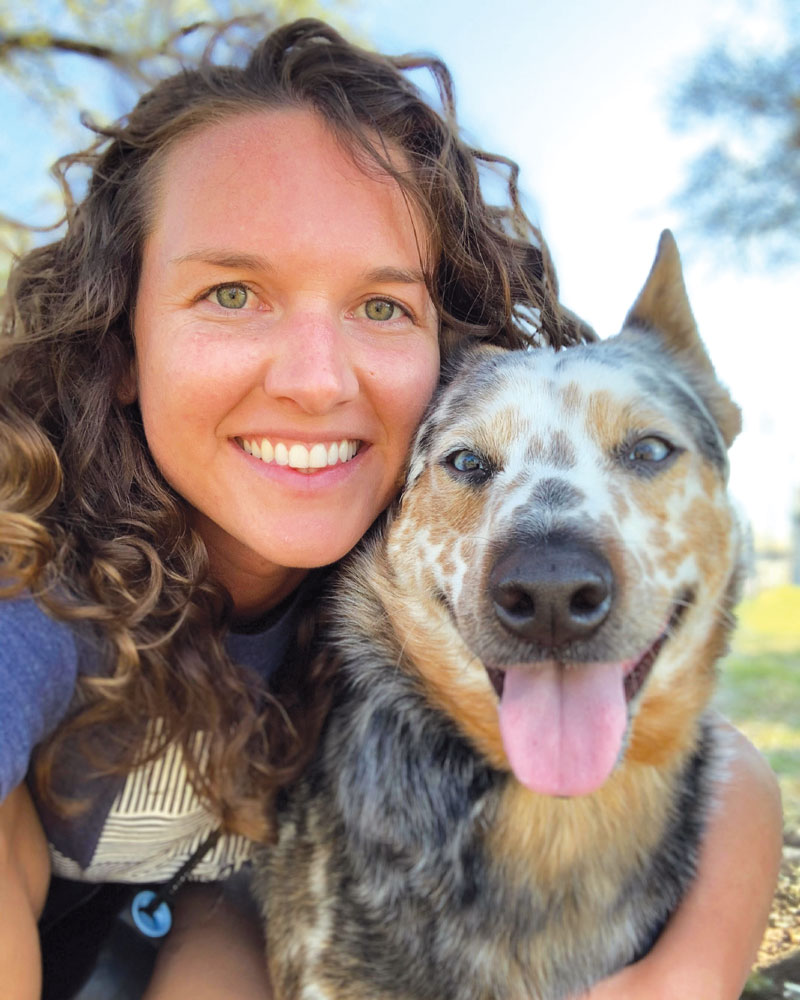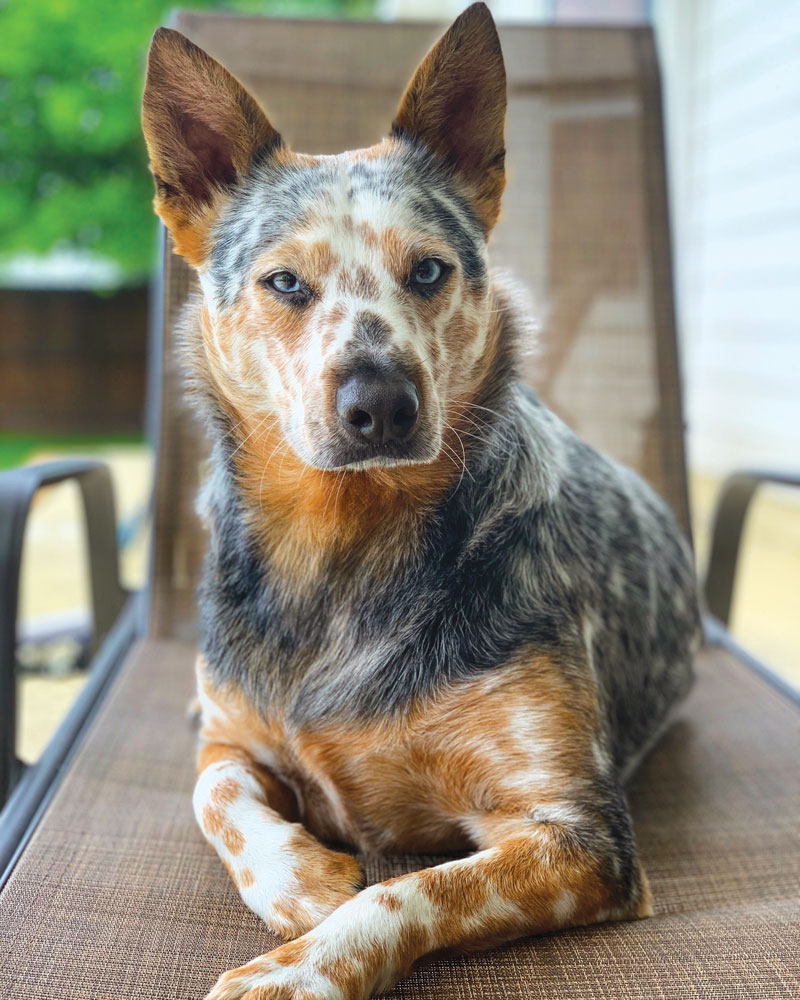

Deaf Dogs Can Do It All
United by deafness, a woman and her rescue pup are on a mission to show that deaf dogs make incredible pets
They say that close friends can comfortably share a silence. If so, Karlie Waldrip and Rhett are the truest and best of friends.
The 27-year-old Grapevine, TX resident and her Blue Heeler Australian Cattle Dog can enjoy a quiet night at home better than most—they’re both deaf and proud to be.
Waldrip believes that she and Rhett share a unique bond. Born with moderate to severe hearing loss, Waldrip was diagnosed as deaf at ten months old.
Doctors told her parents that, statistically, Waldrip would not learn to read past the third-grade level, and that they had to choose between teaching her sign language or teaching her to speak. The Franke family went to bat for their daughter, and with the help of a home advisor for the deaf and hard-of-hearing, schools that supported her educational needs, and many years of practice, Waldrip beat the odds. She became an exceptional reader, speaker, and is fluent in sign language and lip reading.
There were obstacles. “I felt so left out (of) conversations around me and could not hear certain sounds,” remembers the Austin, TX native. “I became so frustrated seeing people around me laughing, talking, joking, etc. because I could not understand anything unless I was talking one-on-one in a quiet place… I struggled with accepting my deafness when I was younger because I wanted to be ‘normal’ like my peers.”
Karlie Waldrip and Rhett
A cochlear implant—a surgically implanted hearing device that uses a microphone to bypass the hearing process and takes sounds directly to the auditory nerve—and a hearing aid, replaced by a second implant at the end of her high school years helped, but her hearing is not fixed, she said. “When I take off my ‘ears,’ I am completely deaf.”
She had always loved dogs (the Frankes had Papillions when she and her sister were growing up), but it was a deaf-education teacher who’d help cement that lifelong love.
“She had a therapy dog who was deaf,” remembers Waldrip. “She was a huge dog lover and would bring her dog to class every Friday. All of her students became dog lovers because of her.” The teacher incorporated dogs into her lesson plans and taught students how to approach, train, and care for them.
Waldrip not only accepted her identity as a deaf person, but became proud of it. After graduating from Texas State University and becoming an itinerant teacher for the deaf and hard-of-hearing—a job she is “forever thankful for because I get to work with students who have some sort of hearing loss,” she says—Waldrip planned to adopt a deaf dog.
“In some way I felt I could relate to them,” says Waldrip. “I knew there were so many dogs being overlooked just because they were deaf. I wanted to be that person who saw them and gave them the life they deserve.”
She adopted Rhett from a shelter in nearby Gonzalez, TX. “I fell in love with Rhett the second I saw him. He immediately jumped into my arms for a big ol’ hug and kiss then went down to the ground for belly scratches! I loved that he just came right into my arms, he was so comfortable with me.” Shelter staff described it as a match made in heaven.
“The only thing that is different is instead of using voice commands, you use made up hand signs or sign language. The key is to be consistent.”
As soon as Rhett arrived at his forever home, it was time to train. “I knew dogs who were deaf are visual due to my experience of being deaf, she said. “The only thing that is different is instead of using voice commands, you use made up hand signs or sign language. The key is to be consistent.”
First, Waldrip taught Rhett “thumbs up” meaning good boy/good job. “I did this sign every time he did something good with lots of body language of excitement and facial expressions. Dogs who are deaf are very visual so he knew he did something right. I was very consistent with it and he picked up on it really quickly.”
Next, was “check in.” Every time he looked at her, Waldrip gave him the thumbs up with body language, facial expressions, and treats. “This will help them to independently check in with the owner every few seconds in every situation they are in,” she says. “Touch is also critical, in my opinion, to reduce getting startled every time they are touched to get their attention. I would tap him gently, and when he looked, he got thumbs up and praise.” Rhett learned signs for different objects such as ‘car,’ ‘ball,’ ‘sit,’ ‘down,’ ‘dad,’ ‘mom,’ and ‘walk.’
“I would show him the object/thing, then show him the sign, then show the object again along with the sign, teaching him to connect the sign with the object,” she says.
She advises consistency and patience for those training any dog, hearing or not. “Every dog takes a great deal of patience. We all train/learn differently,” she says. “Learn signs or make them up, they work just the same… It is like learning another language—some pick up quickly, some don’t as quickly.”
Rhett
“The challenges really lie with the people just becoming comfortable with using non-auditory communication,” says Terrie Hayward, a certified professional behaviour consultant and dog trainer at Positive Animal Wellness (positiveanimalwellness.com) specializing in non-auditory communication and dogs who suffer from separation anxiety. “Once folks understand how to consistently mark and reinforce behaviours they would like to see more of—as well as accurately interpreting, understanding, and responding to dog body language—communication can be smooth and effective.”
Caribbean-based Hayward—who also has two deaf dogs of her own—is the author of the book, A Deaf Dog Joins the Family: Training, Education, and Communication for a Smooth Transition. She has also done webinars on visual, tactile, and non-auditory communication with deaf dogs and runs a Facebook group called Deaf Dogs Behavior and Training.
Information on deaf dogs is out there in abundance, says Waldrip. “I like joining Facebook groups for dogs who are deaf; they all come together to support and share experiences,” she says.
Rhett, now three, and his mistress are inseparable. “He is my best friend and my shadow,” she says. “It sounds cheesy, but we understand each other. We show the world our abilities and how smart dogs who are deaf truly are.”
She may have rescued him, but he’s supported her in equal measure. When the pair relocated for Waldrip’s new teaching position, he was a magnet for new friends. “People are always stopping to meet us since he wears his ‘deaf dog’ harness and has unique coating for a Cattle Dog.” It seems Rhett has star quality. He won a photoshoot and the pictures the photographer posted on Facebook went viral. In a lightbulb moment, Waldrip made Rhett an Instagram account—@_rhett_the_heeler has more than 17,000 followers—with a mission of educating others about deafness in dogs.
“The fact that we are both deaf is a unique factor that pulls in dog lovers and people in the deaf community,” Waldrip says. She wants people to know that if they fall in love with a dog, deafness should never be a dealbreaker. “Deafness does not define who the dog is or their abilities.”
“Deaf dogs can do everything their hearing counterparts can,” seconds Hayward. “Really, the learning curve is for the humans—in working on understanding how to effectively communicate via visual and/or tactile cues.” These cues can even be taught to dogs that aren’t deaf, Hayward says. “It’s a good idea to begin adding visual or tactile cues to your (and your dog’s) repertoire so that if your dog loses their hearing, you have already begun with some communication tools.”
While deafness affects dogs of all breeds in old age, it is more common in certain breeds such as Dalmatians, Boxers, and Australian Cattle Dogs, says Hayward.
Patricia Belt, an advocate for dogs who were born deaf, has four deaf Dalmatians—Izzy, 10; Astro, six; Ember, four; and Piper, seven months—and a hearing cat named Dutchess in her family.
The Memphis, TN resident founded TN Safety Spotters Inc., a non-profit organization to help rescue deaf Dalmatians, train them, and “set an example of the amazing things deaf Dalmatians are capable of, if given a chance.” Belt and her dogs are fire prevention educators at the Fire Museum of Memphis, work with veterans who have mobility issues at the Memphis VA Medical Center, and do therapy visits at fire stations.
“They make wonderful therapy dogs because they rely on body language and facial expressions to communicate,” says Belt. “They know who needs them the most and will naturally visit them first. Deaf dogs hear, just not with their ears.” Her dogs are also reading education assistant dogs. “Children who have reading difficulties relax reading to a dog, knowing the dog won’t laugh at them when or if they make a mistake,” she says.
When they aren’t working, they’re enjoying happy lives as regular dogs. “I let home be a place where they can relax and feel free to run and be carefree dogs,” says Belt. “They sleep on the couch, play ball, and run in the backyard like any dogs.” They also play nose-work games since they have a keen sense of smell. “There is never a dull moment.”
“If you are willing to commit to one, your life will never be the same,” says Belt of deaf dogs. “You’ll have the best friend you’ve ever had. They will understand your moods and be there for you through good times and bad… The bond you will have with your dog will be closer than you will ever imagine.”
As for Rhett, “he is deaf and the happiest dog he could ever be,” says Waldrip. “He is living the best life with me. I have given Rhett a voice to educate others about dogs who are deaf in hopes of giving other deaf dogs a chance.”
Answers to the Most Commonly Googled Questions About Deaf Dogs
Dog trainer, deaf dog advocate, and therapy dog evaluator Patricia Belt answers the most commonly Googled questions about deaf dogs.
Q: How do you call a deaf dog?
A: I first teach deaf dogs to check in with me every 30 seconds or so. When they're looking, I give the “come” hand signal. If they're focused on something very distracting and check in, I use hand targeting. I always have something of higher value (better than what they are focused on) and worth coming for. If it's at night, I turn the back porch light on and off. They know to come.
Q: How do you wake a deaf dog?
A: Whether hearing or deaf, you must be careful waking a dog. When training, I tap on their shoulder to wake them up and offer them a high-value treat or game. They learn waking up suddenly means good things are coming. If the dog is known to nip or bite when waking, I lightly stomp on the floor a few steps away. Once they're awake I'll toss them a few treats.
Q: How do you get a deaf dog's attention?
A: When training, teaching “watch” is the very first exercise. If they don't know to “watch,” they can't read hand cues or body language. Every time the dog makes eye contact, I reinforce with a delicious treat. When trained, I can tap on their shoulder, and they turn and look at me. I always have a big smile and thumbs up waiting! Once they learn to watch, getting their attention is not a problem. I never have my dogs off leash unless it's in a fenced, secure area, no matter how well trained they are.
Q: How do you prevent startling a deaf dog?
A: With hearing or deaf dogs, startling can and does occur; it's instinctive. It's how they react that's important for our safety. Training a deaf dog with gentle taps from behind and reinforcing good behaviour and being able to keep triggers or surprises to a minimum helps teach them to react in a positive way.
Join the newsletter and never miss out on dog content again!
"*" indicates required fields
By clicking the arrow, you agree to our web Terms of Use and Privacy & Cookie Policy. Easy unsubscribe links are provided in every email.

